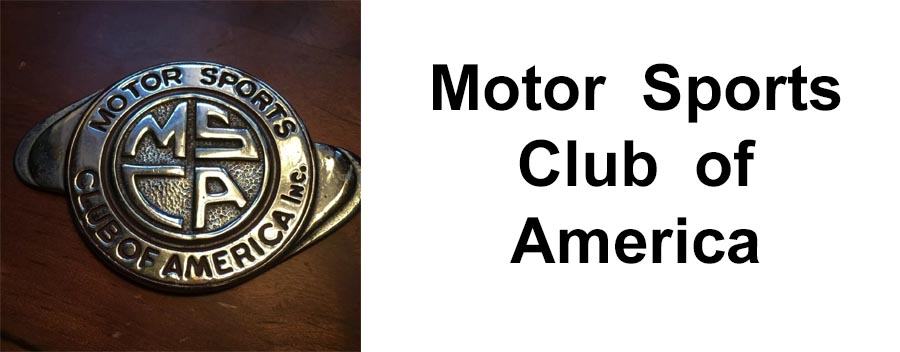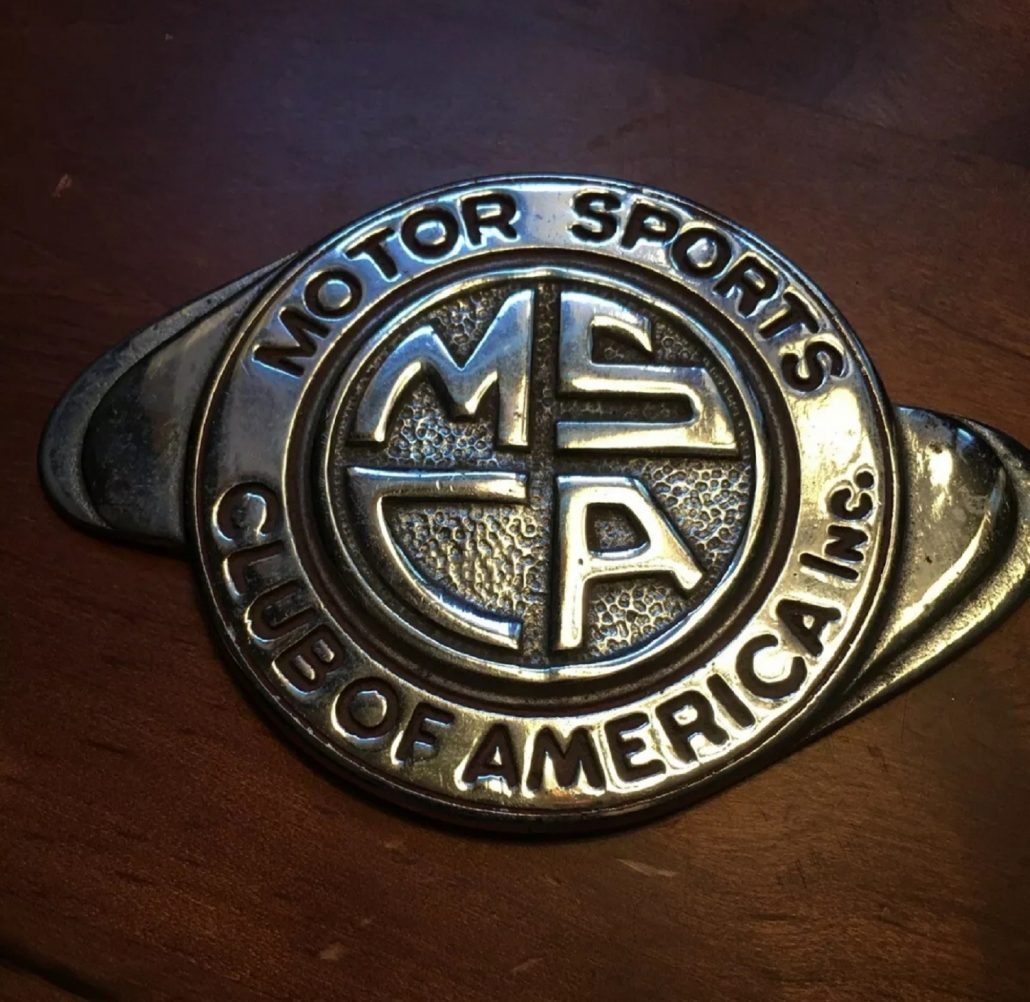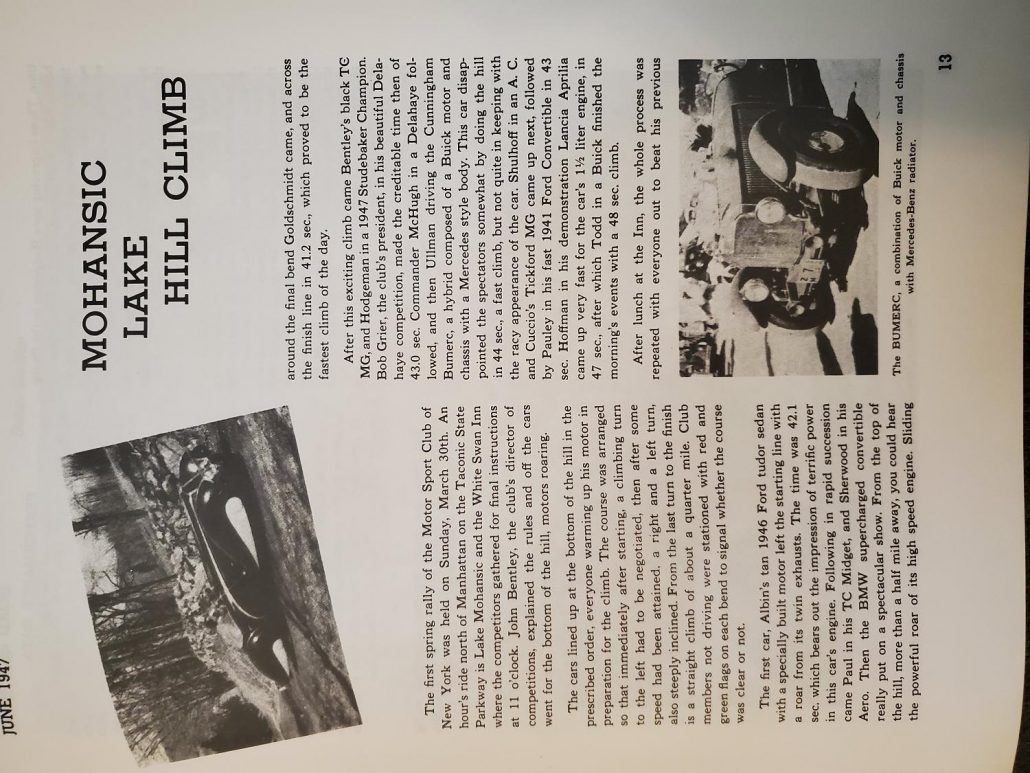
Hi Gang…
I love early postwar sports car history – especially that from the 1940s. It’s practically non-existent. We think of American sports and race car history as a 1950s phenomenon – and that would be correct. Except it started years earlier – actually before World War II ended.
What we now know as the Sports Car Club of America published their first newsletter called “SportWagen” in March, 1944. Within a year the newsletter would take on the name we know it as today which is “Sports Car.” And that’s what makes this fascinating research to me. The early history is the foundation of our hobby and the genesis of the sport. How much more provocative could it be? Let’s find out.

First Issue of the SCCA Newsletter in March, 1944. Back then the Newsletter Was Called “The Sportwagen”
My passion for learning about American sports car history of the 1940s isn’t shared by many people. But one of my good friends shares this passion – and he’s one of the best researchers I know out there. Who is this person? None other than Joel Driskill who has shared his research with us here at Undiscovered Classics for over ten years.
Recently I saw a post of Joel’s on Facebook sharing 1940s sports car history that I had not heard of before. I asked him if we could share his story with our readers and he kindly agreed. So without delay, let’s hear from Joel and what he has to share about early postwar sports car history in America. Go get ’em Joel
The Motor Sports Club of America – Early Postwar Sports Car History Emerges
By Joel Driskill
I recently was able to acquire the Motor Sports Club of America (MSCA) badge shown above for my collection. Due to the club’s almost forgotten existence and its small regional membership (northeast), I didn’t think that I would ever find one. I can’t imagine many people were looking for these and perhaps that’s how I was able to acquire it. Here is a little context concerning the badge, and please note. Much of the following information about the MSCA appears in the book (American Road Racing: 1948-1950) by the acclaimed automotive researcher Joel Finn.
In 1945, the Sports Car Club of America (SCCA) had a discriminatory habit, if you didn’t have the right kind of job or were from a low social standing, they would not admit you into the club. They also had an anti-Semitic streak. After being blackballed out of membership to the SCCA because of their Jewish religion, Bob Grier and Larry Kulok (both had jobs in the fashion industry in NY) decided to start their own club – the Motor Sports Club of America (MSCA). Despite the setback of being excluded from the SCCA, the formation of the MSCA would prove to be an important step in the growth of road racing in the U.S.
The SCCA at the time (1945) wasn’t a racing organization as we know it today, its mission was the preservation of prewar sports cars, as many thought the Automobile Racing Club of America (ARCA) was going to pick back up after the war where it had left off – which we know never did. After formation, the MSCA almost immediately held informal hill climbs and rallies in 1946, which made it the first sports car club to hold events postwar. When John Bentley (period author concerning sports cars) joined the club, he took over as the competition director and the hill climbs took a more serious tone. Road and Track Magazine’s first issue (June 1947) covered one of MSCA’s more formal hill climbs at Mohansic Lake. This Road & Track article is shown at the end of today’s story.
The MSCA’s popularity among sportscar owners was evident in fact that they grew to be larger than the club that had rejected Grier and Kulok. This was despite the fact that the MSCA was a NYC centric organization compared to the SCCA’s nationwide membership. The growth of the club was mostly because the MSCA had no criteria to become a member (other than being a sports car enthusiast) and they were the only sports car club that organized racing.
Many members of the SCCA joined the MSCA, including Alec Ullman who formed the SCCA’s NY metropolitan region and was a former ARCA member. Although the MSCA never put on a true road race that I know of, their activities pushed the SCCA’s members to demand the SCCA hold events and eventually loosen its requirements for membership. Without this impetus, the first postwar road race may not have been Watkins Glen and the SCCA may have become a completely different organization.
Johnny Von Neumann was on the East Coast in 1948 for business and attended one of MSCA’s events. Their event severed as an inspiration for him to hold his own events back in California. This inspiration helped form the California Sports Car Club on the west coast.I would explain how big of a deal this became but that story will have to wait for another day.
There is a lot about this MSCA badge that I love: its rarity, historical importance, and its symbolism of inclusion and diversity – an openess to all which helped make the organization better – even if it was just a flash in the pan.
Road & Track Article: Issue #1 – June, 1947
Motor Sports Club of America Event
Summary:
Great thanks to Joel for sharing his story today – history which I had never heard of until he graciously shared it with all of us. Thank you Joel. For those of you who would like to read more stories that Joel has shared with us here at Undiscovered Classics, click on the link below.
Click Here to View Stories Authored By Joel Driskill Here at Undiscovered Classics
Hope you enjoyed the story, and remember…
The adventure continues here at Undiscovered Classics.
Geoff




Geoff, what a great site, I could not help but read every word on every line on every page and enjoyed all of it. I will send you an email of a publication from the Paradise Car Club, a local British Club as there is an article That Was The Way It Was or Back Then. something like that you might find interesting.
Hello Geoff,
I enjoyed reading the article on the MSCA that I found on your website while searching for info on my father, Bob Grier, who founded that club. I am in the process of writing a book on my father and his involvement in sports car racing in the 40’s and 50’s. Altho I have files full of racing memorabilia, photos and memories of growing up on race tracks I would appreciate any stories about him that still linger.
Thanks
Lucy Grier Feller
Hello Lucy:
I Have been the Rally Master for The Great American Mountain Rally Revival for the last 3 years.
I have collected quite a bit of info, especially from ’55-’56 as I meet one of the original competitors and he was kind enough to allow me to scan all the info.
I know your dad was heading up the event for at least those two years. aka GAMR
Can you tell me if you have any info about the event you could share with me, I have most of my info scanned and would be happy to share with you.
I am sorely lacking ’53-’54 info.
Best Regards:
Gary Hamilton
Rally Master Great American Mountain Rally Revival – GAMR
Hi Gary, would be happy to share any info I have. Give me a day or two ,still organizing all the material. that I have.
Lucy Feller
Hi Lucy
How can we connect directly via email?
Gary,
My email is below
I have ruffled thru some folders as I am in the beginning of organizing the book. I have found so far very little on the MSCA. I have the same article with the picture of the cadillac Allard, and I do have a print out of the Great American Mountain Rallye dated 1955, by Frank M Blunk.If you are interested, I can scan it and send it to you. Do you want to receive it by email?Nice long review with plenty of info and a map showing the route of th 3 day rallye
1500 mile event-Run by the MSCA.
Lucy. loopdelulu2@yahoo.com
Hello all:
Great to find some info on MSCCA. I have been the rally master for the Great American Mountain Rally Revival for the past 3 years.
The event First ran in 1953 and was the first FIA sanctioned road rally which was put on by MSCCA. I have by default become the official archivist of this event and have collected a myriad of information and photos from the 1955 & 1956 event. The event was run every Thanksgiving starting in NYC; ran to the Canadian border and back to Poughkeepsie (1100 miles) in 3 days & nights.
I have copies of the original Rally Program, including General Instruction and actual Route instructions with calculations in the margins!
Too much to tell here, but I will say that Stirling Moss ran for the Rootes Group in 1953 in an Alpine! Fangio was Also the started one year.
I am always seeking information about this event and would love to hear from anyone who may have info on this event.
Link to story Hemmings did on our event:
https://www.hemmings.com/stories/2018/10/28/re-starting-a-new-england-tradition-with-the-great-american-mountain-rally-revival
https://www.hemmings.com/stories/2020/02/07/the-great-american-mountain-rally-revival-keeps-getting-better-with-its-second-run
Visit my FB page for lots of info:
https://www.facebook.com/historicrallyrevival/
Thanks for the suggestion re the Huth Custom Caddy Geoff. Looks like a very nice car, very well built. I hope it’s still on the road. Kind regards, Ken
Hey, Geoff, thanks for the heads up as I do get a daily post from Hemmings and I will be sure to read this one.
Hello Geoff,
When I was a kid back in the middle 50’s I saw an add in I think Popular Mechanics or a car magazine (I subscribed to R&T in 55) for a club called the “Auto Maniacs”. I wrote to them and received a letter back (still have it) of how to join and their benefits of providing a news letter, brochures and other perks. I think it was $5 to join for the year. I didn’t join and am still sorry about it. I’m still an auto maniac. Have you heard of it and know any more. Thanks for your site.
Bill….nice to meet you and thanks for your reply. I’ve not heard of the Auto Maniacs before but I did some research and found the ad. I’ll send it to you via e-mail. Can you scan the letter you received back and send it to me via e-mail at Geoffrey.Hacker@Gmail.com I’ll send you what I found tonight and let’s plan to do a story and find out more about this club. Should be fun Thanks for checking in and stay well. Geoff
Thanks for checking in and stay well. Geoff
This is interesting history and it is not surprising that the SCCA was snobbish and looked down their nose at you if you were not part of the “in” group and there are still remnants of it today which is the main reason that NASA (National Auto Sport Association) is popular and has grown so fast.
@Ralph Bush – Thanks for checking in and sharing your thoughts. Hemmings posted our story today (6/27/20) on their website to share with their readers so it must be good history to share with all – lessons to be learned. Stay well my friend. Geoff
A friend of mine in South Africa, the Late Tony Day, was the Natal Mercury and Daily News motoring correspondent and was also heavily involved in classic car clubs. His definition of a “sports car” was that if you could touch the road without getting out of the car then it was a “sports car.” Therefore Austin Healey’s, Triumph TR’s, MG’s, Morgans, Swallow Doretti’s etc. were automatically known as sports cars. If you were unable to touch the road then it was known as a Tourer.
@Ken Tilly – cool way to define a sports car. Check out the Huth Custom Cadillac made in the late 1940s by a friend of mine – Gerry Huth. If you find a photo of it, you’ll see it’s a much larger car but he would light a match from the drivers seat on the ground at a stop light. Very low car too. If you can’t find a photo of it then e-mail me at Geoffrey.Hacker@Gmail.com and I’ll send you a photo. Definitely not a sports car though. Thanks for checking in. Geoff
For European people like me, from FRANCE, this historic story of all main US clubs, about cars and/or racing is absolutly FORMIDABLE to enlight some confuse acknowledement we think to have about US racing clubS.
Thank you the author, and congratulation to the graciously way he has about the way to use his bird pen, sized INKED.
Sorry for my english.
Hervé
@Herve – Thanks for sharing your thoughts and glad you enjoyed Joel Driskill’s story. We’re glad to have him with us and our research team here at Undiscovered Classics. Stay tuned here and have fun Best, Geoff
Best, Geoff
FORMIDABLE for European people
I also love the ARCA link to this club. In the writeup for the hill climb, notice that Ullmann is in Cunningham’s BuMerc that Miles Colier drove in the last ARCA race in 1940 at the world’s fair.